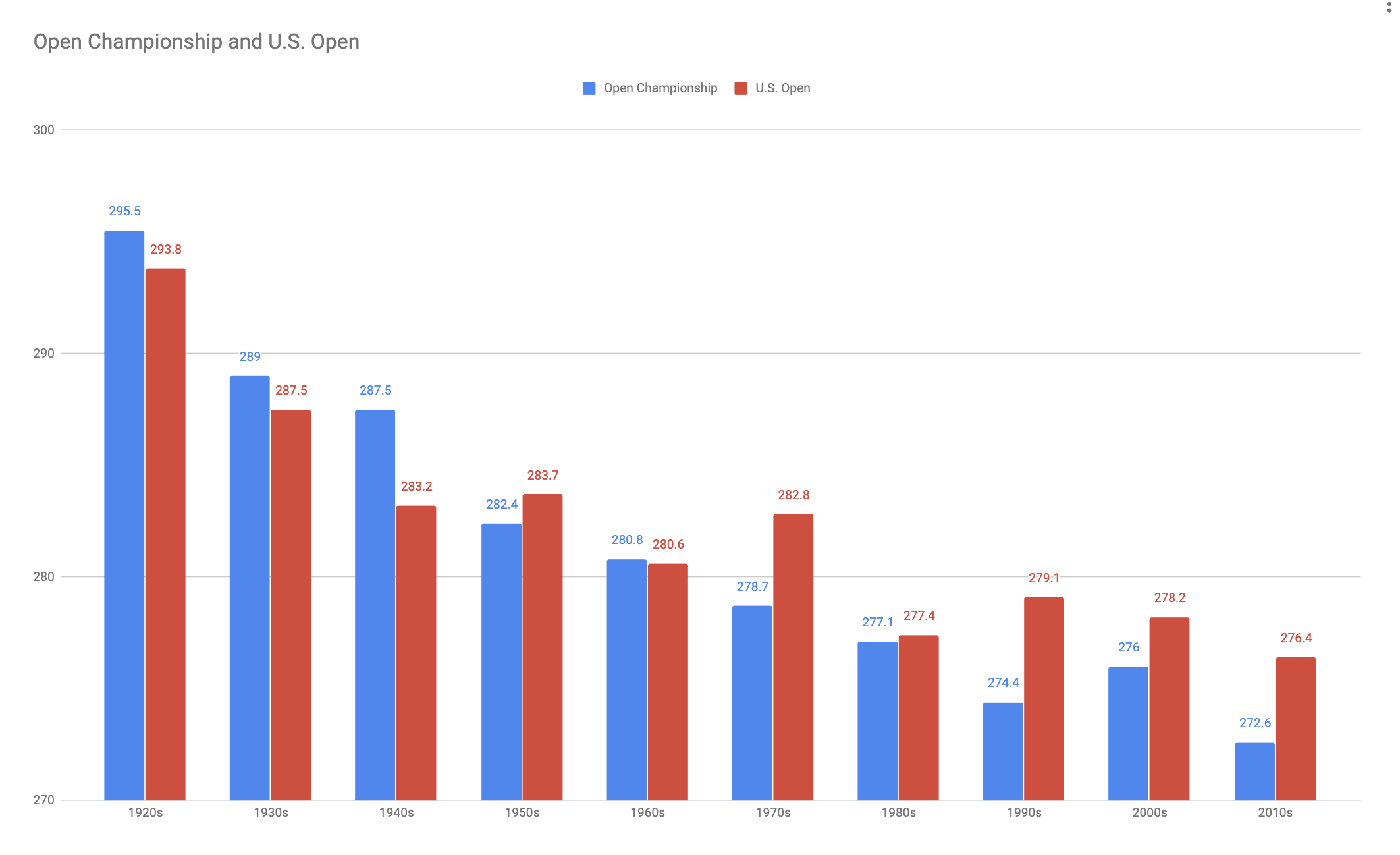In Search of the Traditional U.S. Open
When did the U.S. Open become "the toughest test in golf"?


During today’s coverage of the final round of the U.S. Open, you will likely hear someone refer to “traditional U.S. Open setups.” This phrase has become shorthand for the narrow fairways, thick rough, firm greens, high scores, and manly suffering that supposedly characterized U.S. Opens of old.
Often commentators invoke the phrase to criticize the USGA’s recent efforts to take the national championship to wide courses like Chambers Bay, Erin Hills, and the restored Shinnecock Hills. Some even see this week’s verdant iteration of Pebble Beach, which yielded 26 under-par scores through 54 holes, as a departure from tradition.
But when we say “traditional U.S. Open setups,” which tradition—which era, exactly—are we talking about?
Many would point to the middle of the 20th century, specifically to the 1934-1968 reign of Joseph C. Dey, Jr., as executive director of the USGA. In an entertaining essay for the Golf Channel website last year, Brandel Chamblee praised Dey’s legacy:
“His course setups were not built around consensus, they were driven by one simple overriding philosophy: to find the one player who was most in control of his emotions, mind and golf shots. U.S. Opens were often punishing to the best players and unforgiving, both off the tee and around the green. There was no thought to the recovery…. U.S. Opens were about great execution of the shot at hand, right here and now.”
These claims call for a more in-depth historical assessment than this article will offer, but let’s start with the fact that, until after Dey retired from the USGA in 1968, the cumulative winning scores at the U.S. Open were not consistently higher than those at the Open Championship.

A decade-by-decade comparison of average cumulative winning scores at the Open Championship and the U.S. Open. Note: Because of World War II, only four Opens and six U.S. Opens were contested in the 1940s.
There was one respect, however, in which the U.S. Open may have appeared to be more difficult than the Open. Starting in the 1950s, the U.S. Open’s average winning score to par was substantially higher than the Open’s. That was because the USGA had begun assigning a par of 70 to nearly all national championship venues.

A decade-by-decade comparison of average winning scores to par at the Open Championship at the U.S. Open. Note: The U.S. Open began tracking score to par in 1930; the Open did not follow suit until 1938.

A decade-by-decade comparison of the average assigned par values of Open Championship and U.S. Open courses
These numbers do not in themselves debunk the notion that the U.S. Open was a more demanding test of golf than the Open. For that, we would need to look at average scores for the entire field. Still, the general historical trends in winning score and assigned par suggest that we need to rethink some common assumptions.
First, Joe Dey’s great innovation may not have been the “traditional U.S. Open setup.” It may instead have been discovering how to manipulate par in order to market his organization’s premier championship as “the toughest test in golf.” The South Course at Oakland Hills, for instance, has always played to a par of 72 for members. For the past five U.S. Opens it has hosted, however, it has been a par 70. Thus, Ben Hogan won in 1954 with a score of +7, not -1.
Second, when pundits mention “traditional U.S. Open setups,” we would do well to be skeptical. Cumulative winning scores at U.S. Opens did not become decisively higher than those at Open Championships until the 1990s. Yet when people invoke U.S. Open tradition, they seem to have an earlier era in mind. They may simply be confusing nostalgia for history. Many of today’s influential voices—the “Live From” crew of Chamblee, Duval, and Nobilo, for example—played championship golf in the 90s. It’s understandable that they would yearn for that decade, and perhaps occasionally conflate it with prior decades.
Finally, as we watch what promises to be a compelling final round today, let’s not fixate on score to par, or on how this Pebble Beach stacks up against the (likely half-imagined) Pebble Beaches of U.S. Opens past.
Instead, let’s observe the sidehill lies and their influence on shot shapes. Let’s attend to the hollow thud of approach shots landing on firm greens. Let’s see this golf course for what it is: compromised by tightened fairways, shrunken greens, and encroaching infrastructure, but still a sturdy, beautiful, and well-prepared U.S. Open venue.
Leave a comment or start a discussion
Engage in our content with thousands of other Fried Egg Golf Members
Engage in our content with thousands of other Fried Egg Golf Members
Get full access to exclusive benefits from Fried Egg Golf
- Member-only content
- Community discussions forums
- Member-only experiences and early access to events











Leave a comment or start a discussion
Lorem ipsum dolor sit amet, consectetur adipiscing elit. Suspendisse varius enim in eros elementum tristique. Duis cursus, mi quis viverra ornare, eros dolor interdum nulla, ut commodo diam libero vitae erat. Aenean faucibus nibh et justo cursus id rutrum lorem imperdiet. Nunc ut sem vitae risus tristique posuere. uis cursus, mi quis viverra ornare, eros dolor interdum nulla, ut commodo diam libero vitae erat. Aenean faucibus nibh et justo cursus id rutrum lorem imperdiet. Nunc ut sem vitae risus tristique posuere.